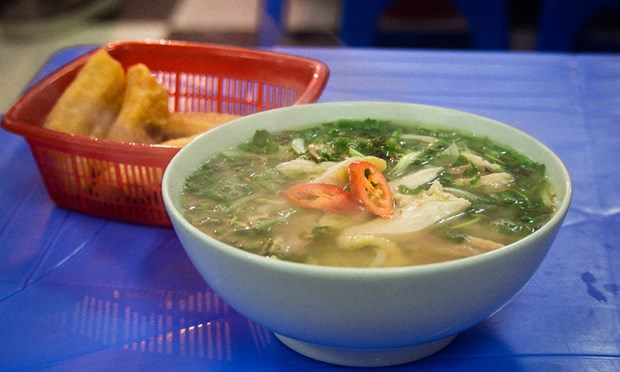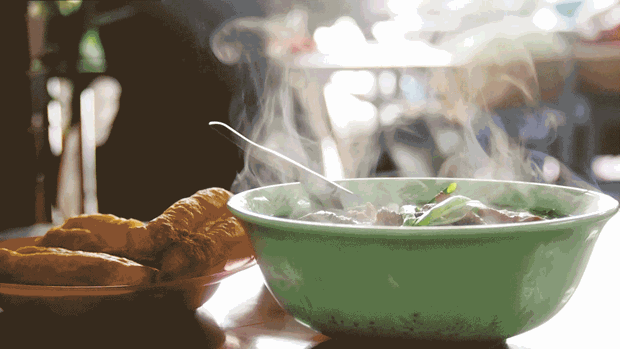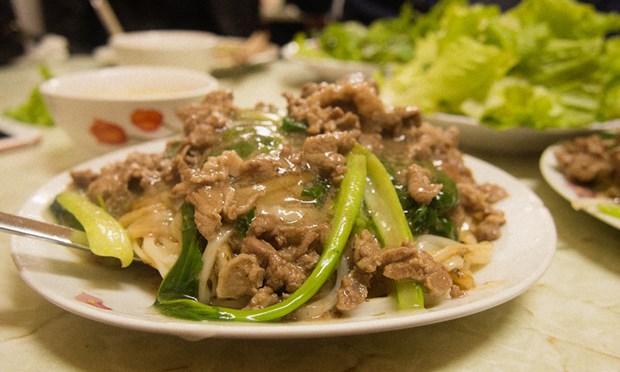In which we learn it's far more satisfying to eat noodles than to think about them.
Way
back in 1952, Vu Bang crowned pho
Hanoi's “fundamental food” after thinking about the dish and the space it
occupied in his beloved city for far longer.
Vietnamese
scholars started waxing poetic about pho
when it entered the Vietnamese lexicon, about two decades before Bang weighed
in. They have continued to do so, ever since.
One
of Bang's contemporaries, essayist Nguyen Tuan, described the noodles as a kind
of currency, during wartime.
“The
homeless dealing at black markets count their commission in bowls of pho,” he wrote. “If a deal turns out
right, they'll pocket a hundred bowls of medium-rare pho.”
In
his book “Hanoi Delicacies”, Vu Bang
noted that some stalls had taken it upon themselves to “improve pho.” Thirty years before his book
dropped, Bang had taken a shining to a family on Hang Chieu Street who offered
a version of the noodles dressed in sesame oil and tofu. Another shop, on Phu
Doan, began adding oil squeezed from the ass of a waterbug.
Bang
did not approve of additions of duck, chopped carrot or pickled papaya.
But
he did approve of experimentation, in general, which brought Hanoi chicken pho, fried pho and other perversions that survived the test of time.

Chicken pho.
The
only test of a pho's merits that
interested Bang was the taste test. In his recollection, it was the only thing
that mattered to anyone.
“Words
get around: if a pho stall is good,
the capital knows within 10 days,” Bang wrote while spying in Saigon. “If the
quality dips, customers disappear in just two weeks.”
Bang
judged the merits of a given stall by how many bowls he could eat in a single
sitting.
His
favorites enticed him to order three in a row — even if the bowls contained
nothing but noodles and the broth, a Spartan order he called “vegan” (pho chay) despite the flavor it derived
from bones.
“On
some days you feel like going vegan,” he joked. “A good broth excels without a
shred of meat.”

A bowl of pho at Pho Bo Long Thanh, Hanoi.
Bang
once spent hours watching Trang, a peddler he crowned “The Pho King of 1952” to see if he could figure out how the man always
managed to draw a line of nearly a hundred customers to his stall, every
morning.
“That
lifeless creature, despite being harangued by 80, 90 people, played blind and
deaf,” he wrote. “He'd stand there stolidly chopping meat, pouring broth and
fish sauce.”
As
he dug through his noodles, sipped his broth and considered possible shortcuts
— everything from MSG to squid heads — Bang admitted he didn't really know what
made the soup so good.
Every
now and again, he'd rip up some mint and throw it into the mix and just give up
wondering.
“[Eating
it] feels more satisfying than knowing the ins and outs of pho,” he said, offering wisdom that seems most valuable today, when
pho thought has devolved into a kind
of cultural mine field.
Earlier
this year, when a white Philadelphia chef described how he liked to eat the
dish, he was pilloried for something called “cultural malpractice.”
But
when I pictured poor Tyler Akin pulling a pho
cart onto a sidewalk in Hanoi in the 40s and slicing up a jalapeno, while
pleading with customers to eschew the hot sauce, I imagine Vu Bang and his pho
comrades would happily give his offerings a try.
Nowadays,
Hanoi bustles with pho noodle salad (pho tron), fried pho (pho xao), fried pho
crackers (pho chien phong) and even pho drenched in bordelaise sauce (pho sot vang). According to historian
and physicist Trinh Quang Dung, the latter has been around for at least 50
years.

Fried pho (pho xao)
New
variations are certainly around the corner, but it seems as though we've
reached a kind of saturation point in the writing and talking about the
national noodles.
Like
Bang in his day, we find pho edicts
less interesting than pho eating.
In
fact, we may have finally hit a point where it's OK for us to stand on a Hanoi
street corner and shout “I don’t like pho”
or “pho is overrated.”
No
one would likely argue with you and some might even agree.
By Quynh Trang/ VnExpress